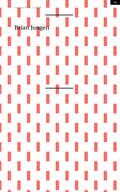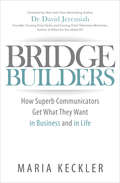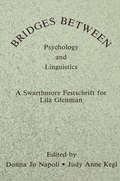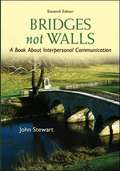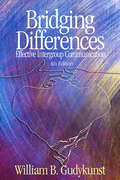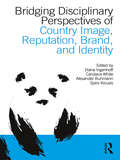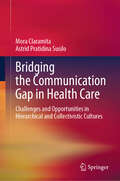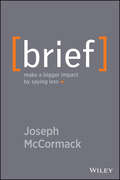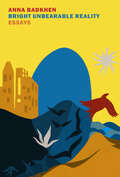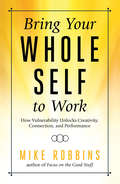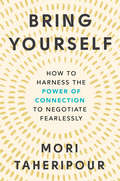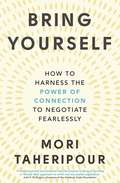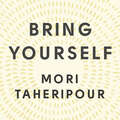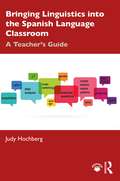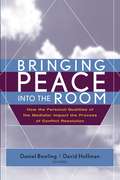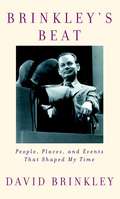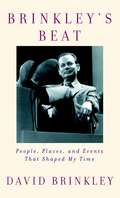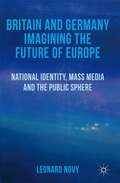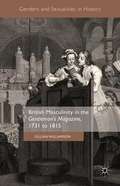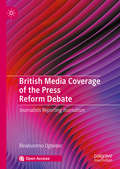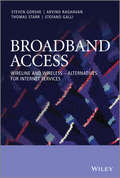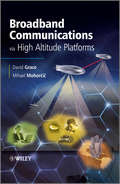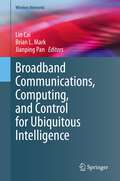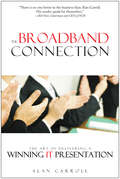- Table View
- List View
Brian Jungen
by Clint Burnham Zoë Gray Brian Jungen Solange De Boer Homi BhabhaPublication initially published in print on the occasion of the exhibition Brian Jungen at Witte de With, 2 Dec 2006 to 11 Feb 2007.
Bridge Builders: How Superb Communicators Get What They Want in Business and in Life
by Maria KecklerA powerful fable that delivers a simple but highly effective blueprint for communication success in business and beyond. How we choose to communicate determines the difference between success and failure—in all of our endeavors. Bridge Builders is a compelling fable of self-discovery about Daniel Reed&’s journey from ordinary communicator to inspirational Bridge Builder. It&’s about the power of crafting messages through the eyes of our audience. It&’s about learning to craft our message differently as others&’ needs become the impetus behind our message. No matter who you are or what you do, incorporating key Bridge Builder principles and best practices will revitalize your vision for the way you connect with people. Bridge Builders gives you the strategic tools you need to connect to the hearts and minds of your audiences and achieve the objectives that are important to you.
Bridges Between Psychology and Linguistics: A Swarthmore Festschrift for Lila Gleitman
by Donna Jo Napoli Judy Anne KeglWritten as a tribute to Lila Gleitman, an influential pioneer in first language acquisition and reading studies, this significant book clearly establishes the relationships between psychology and linguistics. It begins with a thorough examination of issues in developmental psychology, continues with questions on perception and cognition, studies the realm of psycholinguistics, and concludes with an exploration of theoretical linguistics.
Bridges Not Walls: A Book About Interpersonal Communication
by John StewartSince the first edition in 1973, Bridges Not Walls has examined the power and promise of interpersonal communication in intimate relationships, families, communities, and cultures. The text presents a broad range of scholarly and popular articles drawn from several disciplines, including communication, psychology, and philosophy, all chosen for their understandability and practical applicability. Within these readings are thought-provoking discussions of interpersonal contact, identity-management, verbal and nonverbal cues, perception, listening, assertiveness and self-disclosure, family communication, intimacy and social support, defensiveness and hurtful communication, conflict management, culture, and dialogue. Together, the readings emphasize the social and relational elements of human communication, the overlapping influence of verbal and nonverbal cues, the prominence of culture, and the close connection between quality of communication and quality of life.
Bridging Differences: Effective Intergroup Communication
by William B. GudykunstThe Fourth Edition of Bridging Differences: Effective Intergroup Communication builds on the strengths of the previous editions and provides state-of-the-art knowledge about intergroup communication. This new edition brings a strong skills-oriented approach to improving communication effectiveness between people from different groups (e.g., cultures, ethnic groups, social classes). Bridging Differences is based on the assumption that the processes operating when we communicate with people from other groups are the same processes operating when we communicate with people from our own groups. Author William B. Gudykunst has written this book from the perspective of "communicating with strangers" and addresses how factors related to our group memberships (e.g., inaccurate and unfavorable stereotypes of members of other cultures and ethnic groups) can cause us to misinterpret the messages we receive from members of those groups. New to the Fourth Edition: Expanded discussions of several topics such as changing intergroup expectations; cultural differences in attribution processes; cultural and ethnic differences in conflict; cultural differences in indirect messages; cultural differences in uncertainty management; empathy; ethnic and cultural identities; face and its relationship to conflict management; intergroup communication effectiveness; intergroup conflict; intergroup biases; negotiating means; perceptual processes; and prejudice New material has been added on civic engagement; community in public life; diversity and community; the content of stereotypes; communication in romantic relationships; cultural differences in effective communication; and theoretical explanations for prejudice Pedagogical features include end-of-chapter study questions, self-assessment questionnaires, open-ended questions to stimulate readers to think about their implicit theories, and written skill exercises to increase students′ skill development Designed for students taking courses in Intercultural Communication or Intergroup Communication, Bridging Differences is also useful for many courses in Cultural Studies, Anthropology, Sociology, and Management.
Bridging Disciplinary Perspectives of Country Image Reputation, Brand, and Identity: Reputation, Brand, and Identity
by Spiro Kiousis Diana Ingenhoff Candace White Alexander BuhmannCountry image and related constructs, such as country reputation, brand, and identity, have been subjects of debate in fields such as marketing, psychology, sociology, communication, and political science. This volume provides an overview of current scholarship, places related research interests across disciplines in a common context, and illustrates connections among the constructs. Discussing how different scholarly perspectives can be applied to answer a broad range of related research questions, this volume aims to contribute to the emergence of a more theoretical, open, and interdisciplinary study of country image, reputation, brand, and identity.
Bridging the Communication Gap in Health Care: Challenges and Opportunities in Hierarchical and Collectivistic Cultures
by Mora Claramita Astrid Pratidina SusiloThis book discusses how hierarchical and collectivist cultures contribute to the challenges and opportunities in communication in health care. Failures in communication may result in threats to patient safety. The work is structured around the Hofstede theoretical framework, focusing on two of the six domains of culture, namely hierarchy and collectivism. To date, guidelines on communication practices in health care have been primarily based on Western evidence and thus do not satisfy the needs of other cultural contexts. Existing studies have shown that strong hierarchical and collectivist cultures, transnationally, have different communication practices, with shared characteristics between several countries in Asia, Africa, and South America. Furthermore, when people migrate, they bring their communication styles — which reflect their cultural characteristics — to their new host environment. When not well managed, these differences can yield problematic communication gaps affecting patient care. Building on their extensive work focused on healthcare communication in Southeast Asian cultures, the authors propose remedial approaches and discuss future initiatives for practicing doctors, nurses, pharmacists, and other healthcare practitioners who encounter the daily struggle of cultural miscommunication in their clinical practices. They also address the ways in which patients experience hesitancy when communicating with healthcare providers, owing to cultural barriers. The book proposes how healthcare providers might tackle these communication challenges. It is relevant to educators and researchers in medical and health professions education and public health, and for all patients' advocates, who are looking to enhance their communication skills to improve patient care and safety.
Brief: Make a Bigger Impact by Saying Less
by Joseph McCormackGet heard by being clear and concise The only way to survive in business today is to be a lean communicator. Busy executives expect you to respect and manage their time more effectively than ever. You need to do the groundwork to make your message tight and to the point. The average professional receives 304 emails per week and checks their smartphones 36 times an hour and 38 hours a week. This inattention has spread to every part of life. The average attention span has shrunk from 12 seconds in 2000 to eight in 2012. So, throw them a lifeline and be brief. Author Joe McCormack tackles the challenges of inattention, interruptions, and impatience that every professional faces. His proven B.R.I.E.F. approach, which stands for Background, Relevance, Information, Ending, and Follow up, helps simplify and clarify complex communication. BRIEF will help you summarize lengthy information, tell a short story, harness the power of infographics and videos, and turn monologue presentations into controlled conversations. Details the B.R.I.E.F. approach to distilling your message into a brief presentation Written by the founder and CEO of Sheffield Marketing Partners, which specializes in message and narrative development, who is also a recognized expert in Narrative Mapping, a technique that helps clients achieve a clearer and more concise message Long story short: BRIEF will help you gain the muscle you need to eliminate wasteful words and stand out from the rest. Be better. Be brief.
Bright Unbearable Reality: Essays
by Anna Badkhen2022 National Book Awards Longlist for Nonfiction Essays about migration, displacement, and the hope for connection in a time of emotional and geopolitical disruption by a Soviet-born writer and former war correspondent.Called a &“chronicler of a world on the move&” by The New York Review of Books, Anna Badkhen seeks what separates and binds us at a time when one in seven people has left their birthplace, while a pandemic dictates the direst season of rupture in humankind&’s remembering. Her new essay collection, Bright Unbearable Reality, comprises eleven essays set on four continents—roving everywhere from Oklahoma to Azerbaijan—and united by a common thread of communion and longing. In these essays, Badkhen addresses the human condition in the era of such unprecedented dislocation, contemplates the roles of memory and wonder in how we relate to one another, and asks how we can soberly and responsibly counter despair and continue to develop—or at least imagine—an emotional vocabulary against depravity. The subject throughout the collection is bright unbearable reality itself, a translation of Greek enargeia, which, says the poet Alice Oswald, is &“when gods come to earth not in disguise but as themselves.&” Essays include: • In &“The Pandemic, Our Common Story,&” which takes place in the Great Rift Valley of Ethiopia, one of the locations where humankind originated, the onset of the global pandemic catches Badkhen mid-journey, researching human dispersal 160,000 years ago and migration in modern times. • In &“How to Read the Air,&” set mostly in Philadelphia, Badkhen looks to the ancient Greeks for help pondering our need for certainty at a time of racist violence, political upheaval, and environmental cataclysm. • &“Ways of Seeing&” and the title essay &“Bright Unbearable Reality&” wrestle with complications of distance and specifically the bird&’s eye view—the relationship between physical distance, understanding, and engagement. • &“Landscape with Icarus&” examines how and why children go missing, while &“Dark Matter&” explores how violence always takes us by surprise.
Bring Your Whole Self To Work: How Vulnerability Unlocks Creativity, Connection, and Performance
by Mike RobbinsIn today’s work environment, the lines between our professional and personal lives are blurred more than ever before. Whatever is happening to us outside of our workplace —whether stressful, painful, or joyful —follows us into work as well. We may think we have to keep these realities under wraps and act as if we "have it all together." But as Mike Robbins explains, we can work better, lead better, and be more engaged and fulfilled if —instead of trying to hide who we are —we show up fully and authentically.Mike, a sought-after motivational speaker and business consultant, has spent more than 15 years researching, writing, and speaking about essential human experiences and high performance in the workplace. His clients have ranged from Google to Citibank, from the U.S. Department of Labor to the San Francisco Giants. From small start-ups in Silicon Valley to family-owned businesses in the Midwest. From what he’s seen and studied over the years, Mike believes that for us to thrive professionally, we must be willing to bring our whole selves to the work that we do.Bringing our whole selves to work means acknowledging that we’re all vulnerable, imperfect human beings doing the best we can. It means having the courage to take risks, speak up, have compassion, ask for help, connect with others in a genuine way, and allow ourselves to be truly seen. In this book, Mike outlines five principles we can use to approach our own work in this spirit of openness and humanity, and to help the people we work with feel safe enough to do the same, so that the teams and organizations we’re a part of can truly succeed."This book will offer you insights, ideas, and tools to inspire you to bring all of who you are to the work that you do —regardless of where you work, what kind of work you do, and with whom you do it. And, if you’re an owner, leader, or just someone who wants to have influence on those around you —this book will also give you specific techniques for how to build or enhance your team’s culture in such a way that encourages others to bring all of who they are to work."
Bring Yourself: How to Harness the Power of Connection to Negotiate Fearlessly
by Mori TaheripourA look at how relationships can drive successful negotiation, from an award-winning faculty member at the Wharton School of Business.Contrary to conventional wisdom about what makes a good negotiator - namely, being aggressive and unemotional - in Bring Yourself, Taheripour offers a radically different perspective. In her own life, and in her more than 15 years of experience teaching negotiation, she's found that the best negotiators are empathetic, curious, and present. The essence of bargaining isn't the transaction, but the conversation and human connection. It is when we bring our whole, authentic selves to the table that we can advocate for ourselves fearlessly and find creative solutions that benefit everyone.Taheripour has seen the power of this mindset shift firsthand. In her consulting, her classes at Wharton, and in her work teaching negotiation for the Goldman Sachs 10,000 Small Businesses program, her students and clients experience personal breakthroughs as they face the fears and false narratives that held them back. Bring Yourself explains how our pressure points, personal experience, and even our cultural expectations can become roadblocks to finding common ground, and it offers essential strategies to move beyond them and open our minds. Taheripour argues that regardless of our own perceived ability to negotiate, we must have the courage to engage because bargaining plays a crucial role in every aspect of our lives. We negotiate boundaries with our parents and partners, bedtimes with our kids, and even with ourselves every time we make a pros and cons list to weigh a major decision. Negotiation is how we problem solve and how we find our voice. With eye-opening and empowering stories throughout, Bring Yourself helps readers gain the confidence they need to achieve their goals in work and in life. Timely and provocative, this paradigm-shifting book can transform our world and the way we work together.
Bring Yourself: How to Harness the Power of Connection to Negotiate Fearlessly
by Mori TaheripourContrary to conventional wisdom about what makes a good negotiator - namely, being aggressive and unemotional - in Bring Yourself, Mori Taheripour offers a radically different perspective. In her own life, and in her more than fifteen years of experience teaching negotiation, she has found that the best negotiators are empathetic, curious and present. The essence of bargaining isn't the transaction, but rather the conversation and human connection. It is when we bring our whole, authentic selves to the table that we can advocate for ourselves fearlessly and find creative solutions that benefit everyone.Bring Yourself explains how your pressure points, personal experience and even your cultural expectations can become roadblocks to finding common ground, and it offers essential strategies to move beyond them and open your mind. With eye-opening and empowering stories throughout, Bring Yourself helps readers gain the confidence they need to achieve their goals in work and in life. Timely and provocative, this paradigm-shifting book can transform our world and the way we work together.
Bring Yourself: How to Harness the Power of Connection to Negotiate Fearlessly
by Mori TaheripourContrary to conventional wisdom about what makes a good negotiator - namely, being aggressive and unemotional - in Bring Yourself, Mori Taheripour offers a radically different perspective. In her own life, and in her more than fifteen years of experience teaching negotiation, she has found that the best negotiators are empathetic, curious and present. The essence of bargaining isn't the transaction, but rather the conversation and human connection. It is when we bring our whole, authentic selves to the table that we can advocate for ourselves fearlessly and find creative solutions that benefit everyone.Bring Yourself explains how your pressure points, personal experience and even your cultural expectations can become roadblocks to finding common ground, and it offers essential strategies to move beyond them and open your mind. With eye-opening and empowering stories throughout, Bring Yourself helps readers gain the confidence they need to achieve their goals in work and in life. Timely and provocative, this paradigm-shifting book can transform our world and the way we work together.
Bringing Linguistics into the Spanish Language Classroom: A Teacher's Guide
by Judy HochbergBringing Linguistics into the Spanish Language Classroom is a practical, time-saving resource that allows teachers to easily integrate the most interesting and important findings of Hispanic linguistics into their Spanish language classes. Teachers will find classroom-ready explanations and PowerPoint slides for each topic covered, as well as instructions and materials for in-class activities and take-home projects that will engage students in this fresh take on the target language. Slide presentations for each chapter are available online at www.routledge.com/9780367111960. The book covers aspects of Spanish from the trilled r to the personal a, from Indo-European origins to modern dialects, and from children’s first words to adult speech errors. An innovative set of five linguistics-based essential questions organizes and contextualizes this wide range of material: How is Spanish different from other languages? How is Spanish similar to other languages? What are the roots of Spanish? How does Spanish vary? How do people learn and use Spanish? Fully customizable to teacher and student interest, proficiency level, and time available in class, this book is ideal for Spanish language teachers looking to incorporate valuable linguistic insights into their curricula, even if they lack prior knowledge of this field. It is an excellent resource for Hispanic linguistics courses as well.
Bringing Peace Into the Room: How the Personal Qualities of the Mediator Impact the Process of Conflict Resolution
by Daniel Bowling David A. Hoffman<p>Bringing Peace Into the Room examines the personal qualities that make a mediator effective. The eminent authors of this volume go beyond traditional descriptions of academic training, theoretical orientation, and refinement of technique to confront issues related to personal temperament and the crucial psychological, intellectual and spiritual qualities of the mediation professional–qualities that are often the most potent elements of successful mediation. <p>In this comprehensive resource, Daniel Bowling and David Hoffman bring together a stellar panel of practitioners, academics, teachers, and trainers in the field–Michele LeBaron, Kenneth Cloke, Robert Benjamin, Don Saposnek, Sara Cobb, Peter Adler, Jonathan Reitman, Lois Gold, Marvin Johnson, and others–who share their personal experiences as mediators. Each contributor demonstrates that at the very heart of conflict resolution is the subtle interaction between the parties and the mediator’s personal and authentic style. </p> Bringing Peace Into the Room offers no hard and fast rules, guidelines, or advice to be applied to all mediators as to what personal qualities are best suited for all cases. Rather the book shows that developing an authentic approach to mediation requires constant grounding in self-reflection and self-awareness. This highly original and personally compelling approach to the process of conflict resolution explains how mediators can be aware of their own strengths and weaknesses, and how they can fine tune their own unique qualities for effective practice.
Brinkley's Beat: People, Places and Events that Shaped My Time
by David BrinkleyHere are firsthand profiles of Washington insiders that only an insider himself could have given us: Franklin D. Roosevelt counting out enough cigarettes to get through a half-hour debriefing with the press; May Craig, the first female reporter to penetrate Roosevelt's inner sanctum, who never failed to remind the president that his wife was a newspaper writer, too; Theodore Bilbo, a Mississippi senator and race baiter who effectively became mayor of Washington at a time when it was a segregated provincial town; Jimmy Hoffa, the popular and ill-fated union leader; Lyndon Johnson, whom Brinkley describes as the most impressive and appalling figure he encountered; and Ronald Reagan, whom he found to be the most mysterious of the eleven presidents he covered. Here is also Brinkley's account of President Kennedy's assassination and a poignant remembrance of D-day. David Brinkley was there and saw it all. In the "sour-lovable manner" (Mark Feeney, Boston Globe) of storytelling that he perfected, and in a narrative style that is both "hilarious and instructive" (George Will), Brinkley's Beat gives us his vivid recollections and the intelligence, acuity, and clear-sightedness on which his unimpeachable reputation rested for more than half a century.
Brinkley's Beat: People, Places, and Events That Shaped My Time
by David BrinkleyFrom one of America’s most revered journalists–a richly entertaining roundup of the extraordinary individuals with whom he crossed paths in our nation’s capital and of the events that marked the twentieth century. Here are firsthand profiles of Washington insiders that only an insider himself could have given us: Franklin D. Roosevelt counting out enough cigarettes to get through a half-hour debriefing with the press; May Craig, the first female reporter to penetrate Roosevelt’s inner sanctum, who never failed to remind the president that his wife was a newspaper writer, too; Theodore Bilbo, a Mississippi senator and race baiter who effectively became mayor of Washington at a time when it was a segregated provincial town; Jimmy Hoffa, the popular and ill-fated union leader; Lyndon Johnson, whom Brinkley describes as the most impressive and appalling figure he encountered; and Ronald Reagan, whom he found to be the most mysterious of the eleven presidents he covered. Here is also Brinkley’s account of President Kennedy’s assassination and a poignant remembrance of D-day.David Brinkley was there and saw it all. In the “sour-lovable manner” (Mark Feeney, Boston Globe) of storytelling that he perfected, and in a narrative style that is both “hilarious and instructive” (George Will), Brinkley’s Beat gives us his vivid recollections and the intelligence, acuity, and clear-sightedness on which his unimpeachable reputation rested for more than half a century.
Britain and Germany Imagining the Future of Europe
by Leonard NovyThrough analysis of newspaper coverage on the debate over the future of Europe in Great Britain and Germany between 2000 and 2005, this book explores the intricate ways in which national identities shape media discourses on European integration. In doing so, it provides some compelling insights into Europe's emerging communicative space(s).
British Masculinity in the Gentleman's Magazine, 1731 to 1815 (Genders And Sexualities In History Ser.)
by Gillian WilliamsonThe Gentleman's Magazine was the leading eighteenth-century periodical. By integrating the magazine's history, readers and contents this study shows how 'gentlemanliness' was reshaped to accommodate their social and political ambitions.
British Media Coverage of the Press Reform Debate: Journalists Reporting Journalism
by Binakuromo OgbeborThis open access book provides a detailed exploration of the British media coverage of the press reform debate that arose from the News of the World phone hacking scandal and the Leveson Inquiry. Gathering data from a content analysis of 870 news articles, Ogbebor shows how journalists cover debates on media policy and illustrates the impact of their coverage on democracy. Through this analysis, the book contributes to knowledge of paradigm repair strategies; public sphere; gatekeeping theory; the concept of journalism as an interpretive community; political economy of the press; as well as the neoliberal and social democratic interpretations of press freedom. Providing insight into factors inhibiting and aiding the role of the news media as a democratic public sphere, it will be a valuable resource for the press, media reform activists, members of the public, and academics in the fields of journalism, politics and law.
British Political Culture and the Idea of 'Public Opinion', 1867-1914
by James ThompsonNewspapers, periodicals, pamphlets and books all reflect the ubiquity of 'public opinion' in political discourse in late nineteenth and early twentieth-century Britain. Through close attention to debates across the political spectrum, James Thompson charts the ways in which Britons sought to locate 'public opinion' in an era prior to polling. He shows that 'public opinion' was the principal term through which the link between the social and the political was interrogated, charted and contested and charts how the widespread conviction that the public was growing in power raised significant issues about the kind of polity emerging in Britain. He also examines how the early Labour party negotiated the language of 'public opinion' and sought to articulate Labour interests in relation to those of the public. In so doing he sheds important new light on the character of Britain's liberal political culture and on Labour's place in and relationship to that culture.
Broadband Access
by Stefano Galli Steven Gorshe Arvind Raghavan Thomas StarrWritten by experts in the field, this book provides an overview of all forms of broadband subscriber access networks and technology, including fiber optics, DSL for phone lines, DOCSIS for coax, power line carrier, and wireless. Each technology is described in depth, with a discussion of key concepts, historical development, and industry standards. The book contains comprehensive coverage of all broadband access technologies, with a section each devoted to fiber-based technologies, non-fiber wired technologies, and wireless technologies. The four co-authors' breadth of knowledge is featured in the chapters comparing the relative strengths, weaknesses, and prognosis for the competing technologies.Key Features:Covers the physical and medium access layers (OSI Layer 1 and 2), with emphasis on access transmission technologyCompares and contrasts all recent and emerging wired and wireless standards for broadband access in a single referenceIllustrates the technology that is currently being deployed by network providers, and also the technology that has recently been or will soon be standardized for deployment in the coming years, including vectoring, wavelength division multiple access, CDMA, OFDMA, and MIMOContains detailed discussion on the following standards: 10G-EPON, G-PON, XG-PON, VDSL2, DOCSIS 3.0, DOCSIS Protocol over EPON, power line carrier, IEEE 802.11 WLAN/WiFi, UMTS/HSPA, LTE, and LTE-Advanced
Broadband Communications via High-Altitude Platforms
by David Grace Mihael MohorcicA unique book with systematic and thorough coverage of HAP related issues, problems and solutions. Handbook of Broadband Communications from High Altitude Platforms provides a thorough overview and state of the art of the HAP enabling technologies, as well as describing recent research activities with most promising results. It outlines the roadmap for future development of HAPs. Focuses on placing HAPs in the perspective of current and future broadband wireless communication systems, providing the readers with an overview of the constraints affecting HAP-based broadband communicationsProvides a thorough overview of HAP enabling technologies, describes recent research activities with most promising results, and outlines the roadmap for future development of HAPsCovers enabling technologies and economics of HAP-based communication system including issues related to aeronautics, energetics, operating scenarios, applications and business modelingExamines the operating environment, advanced communication techniques for efficient radio link resource management, and suitable antennasAddresses multiplatform constellations, presenting the multiple HAP constellation planning procedure and discussing the networking implications of using multiple HAPs
Broadband Communications, Computing, and Control for Ubiquitous Intelligence (Wireless Networks)
by Brian L. Mark Lin Cai Jianping PanThis book reports on the latest advances from both industry and academia on ubiquitous intelligence and how it is enabled by 5G/6G communication technologies. The authors cover network protocol and architecture design, machine learning and artificial intelligence, coordinated control and digital twins technologies, and security and privacy enhancement for ubiquitous intelligence. The authors include recent studies of performance analysis and enhancement of the Internet of Things, cyber-physical systems, edge computing, and cyber twins, all of which provide importance guidance and theoretical tools for developing future ubiquitous intelligence. The content of the book will be of interest to students, educators, and researchers in academia, industry, and research laboratories.Provides comprehensive coverage of enabling communications, computing, and control technologies for ubiquitous intelligence;Presents a novel paradigm of ubiquitous intelligence powered by broadband communications, computing, and control;Includes a review of 5G/6G communication technologies, network protocol and architecture design, and ubiquitous computing.
Broadband Connection: The Art of Delivering a Winning IT Presentation
by Alan CarrollIt's no secret that many IT professionals hate presenting and are often very bad at it. Focusing on technical details and speaking in monotone, they can quickly lose their audiences' attention and interest. Effective presentation skills are critical to the careers of IT professionals and the proper utilization of corporate resources.The Broadband Connection will show IT professionals how to become articulate, effective, and persuasive speakers-no matter how difficult the information being disseminated.In The Broadband Connection, author and expert Alan Carroll, a transpersonal psychologist who has helped thousands of IT professionals worldwide evolve from nervous, insecure speakers into savvy, successful presenters, offers his proven strategies in this fresh and innovative step-by-step guidebook. Utilizing language and principles specific to the IT industry, the author teaches vital presentation skills in a familiar language the reader can identify with and understand. This book provides the tools to unleash the graceful speaker hidden inside every IT professional.
